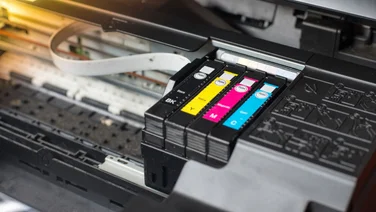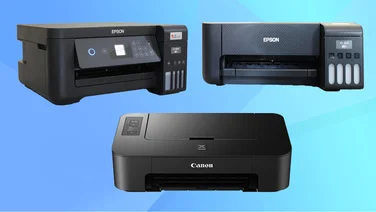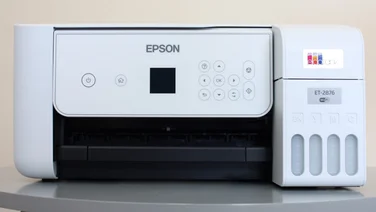To help us provide you with free impartial advice, we may earn a commission if you buy through links on our site. Learn more

The Brother MFC-L8650CDW is a tallish colour MFP that, thanks to some good design, looks a little smaller than it is. Above the printer’s output tray, the black front panel slopes backwards to create a control panel at the front of the scanner bed. Control is via a colour touchscreen, with touch-sensitive buttons that light up when relevant – for example number keys which illuminate when you need to enter a fax number. Other features include support for wired and wireless networks, and duplex (double-sided) printing, scanning, copying and faxing. Brother quotes print speeds of 28 pages per minute (ppm) in black or colour, too.
As with many similar devices, this MFP’s scanner bed sits low over the printer’s output tray. The scanner bed is low enough that it’s tricky to extricate pages if the printer’s flip-up paper stop is raised, although we found we didn’t need the stop to keep printed A4 pages tidy. You can raise the scanner by a few degrees to give better access, if needed. The 35-page automatic document feeder (ADF) has a neat design which folds shut when not in use, keeping dust away from the scanner optics, and the whole scanner lid is on strong hinges with a stay to stop it smashing down when you’re using the scanner glass.
Other components are less impressive, particularly the 250-sheet paper input cassette which is one of the flimsiest we’ve encountered. It’s easy to flex it by an alarming amount, the paper guides have a tendency to stick, and there’s nowhere to get a finger in if you want to unload the paper. Above the cassette is a clattery 50-sheet multipurpose feed; this initially seemed jammed on the front edge of the main tray, but after we’d freed it the problem didn’t recur. It has similarly unpleasant paper guides and isn’t marked with the correct orientation for envelopes. Printing these properly is a hassle as it requires you to access the back of the printer, open the rear hatch and move two levers within, but envelopes did at least print perfectly first time.
Like HP, Brother seems to have mastered touchscreen control panels on its printers. Although the one fitted here isn’t always immediately responsive, it’s completely intuitive, making most operations very simple. We particularly like the ability to create shortcuts for quick access to frequently used features. Insert a USB flash drive in the port on the left and you’re prompted to choose between direct printing or scanning – the latter will work even while the printer is serving a network job.
It’s similarly easy to use this MFP from a PC: Brother’s print driver keeps things simple with shortcuts for everyday jobs, while its scan interface is also straightforward – it’s a shame that it doesn’t have an auto-exposure feature, though. One area Brother could improve is its iPrint&Scan Android app, which complained that most PDF files we sent the printer were either in the wrong format or too large to print. Scanning was more successful, although the options extend only to document size and whether you want to scan in colour or black and white.
When connected to a PC, this is a rapid printer, reaching 21.1ppm on our test text print run and a very impressive 20ppm on our more complex colour graphics test. The printer was also quick when duplexing in colour, printing 10 sides of graphics on five sheets in 63 seconds. Photocopies were extremely fast, with single-page black copies taking 12 seconds, and a 10-page colour copy just 37 seconds. Scans, too, were rapid: capturing an A4 document at 150 or 300 dots per inch (dpi) took 14 seconds, while scanning a 6×4″ photo at 1,200dpi took 33 seconds.
Unfortunately, speed isn’t everything, and many of the results from this MFP were disappointing. Black text was as good as we’d expect from a laser printer, but graphics seemed to be printed with a thin layer of toner, giving them an uneven finish in some dark regions. Colour reproduction tended to be too warm, and in some fill regions there was grain visible to the naked eye. This was particularly the case with photos, in which some lighter areas were also mottled with a blocky pattern, suggesting that the printer simply didn’t have the dynamic range to reproduce all the necessary shades. Our black and white test photo lacked contrast, mono photocopies were too dark at the default setting, and colour ones had poor colour accuracy. Photo scans were quite good, with accurate colours and sharp focus, but detail wasn’t preserved from among the darkest shades, and document scans were slightly under-exposed.
Higher-end models from the same range accept super-high-yield toners rated at 6,000 pages, but the MFC-L8650CDW can’t use these so must make do with a 4,000-page black supply and colour toners rated at 3,500 pages each. Counting toner alone, running costs work out at just 1.1p per black page or 8.4p in black and colour, but factor in longer-term supplies such as drums and the waste toner bottle and these page costs rise to 1.7p and 9.8p respectively. That’s reasonably competitive for the class, but still a lot of money compared to the best-value MFPs we see. While we like this MFP for its speed and ease of use, it feels cheap and nasty in places and many of its results are below par.






